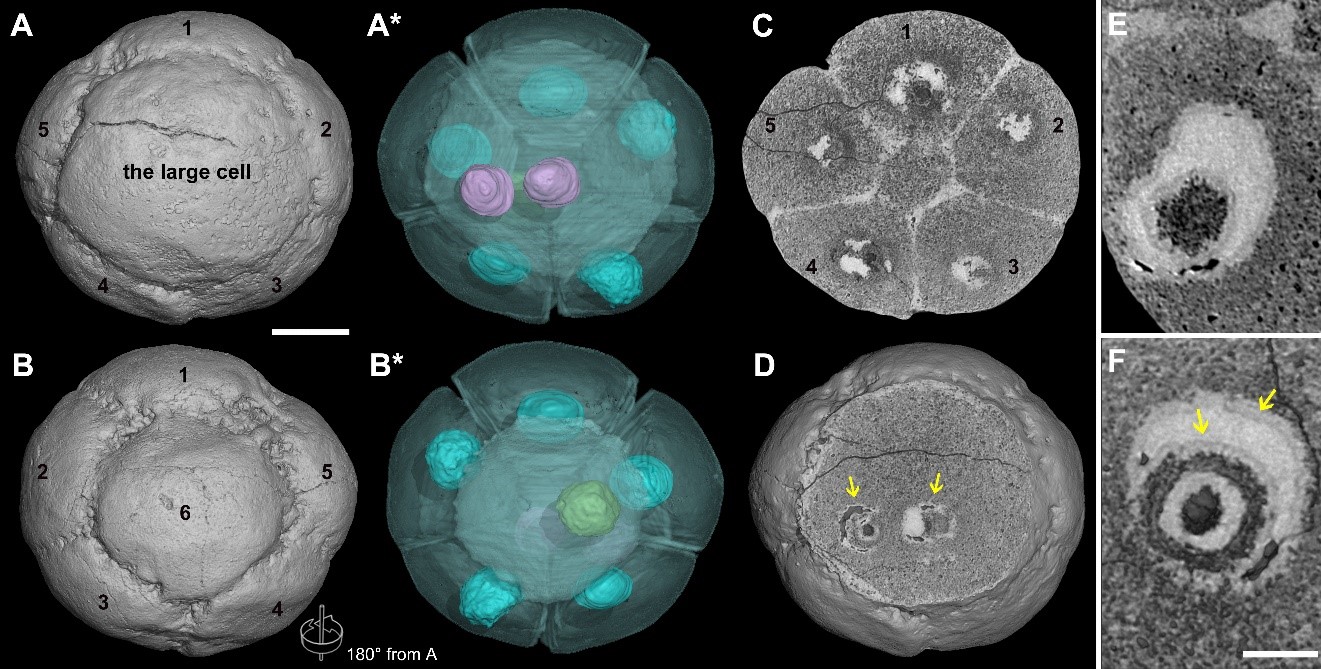
A seven-cell specimen of Tianzhushania
Recently, Dr. YIN Zongjun from Nanjing Institute of Geology and Palaeontology, Chinese Academy of Sciences and his international colleagues from University of Bristol and Swedish Museum of Natural History published a research paper on nuclei structures in embryo-like fossils from the 609-million-year-old Ediacaran Weng’an biota.
As one of the oldest plausible claims of animals in the fossil record, the embryo-like microfossils from the Ediacaran Weng’an Biota have long been expected to afford new insights into the developmental evolution of animal body plans. Furthermore, they are among the most remarkable instances of fossilization, not merely preserving component cells, but also intracellular structures. These include small features interpreted as lipid vesicles or yolk granules and Large Intracellular Structures (LISs) whose interpretation is more controversial. The LISs have a consistent size and location, sometimes occur paired in cells, positioned parallel to an anticipated plane of cell division, and can be elongated or dumbbell-shaped, suggesting possible ongoing division. They were originally considered as nuclei, spindle bundles, or other organelles and most subsequent biological interpretations have focused on a nucleus interpretation.
However, this interpretation has been controversial, perhaps because details of cytokinesis have been invoked to exclude the affinity of fossils from crown-Metazoa, but also because of a prevailing notion that nuclei cannot be fossilized in early eukaryote microfossils. Hence, in this paper, Dr. Yin and his co-authors sought to test the established taphonomic models for the LISs and to reassess their origin not only to constrain affinities of these embryo-like fossils but also to better understand the early eukaryotic fossil record.
Dr. YIN and his colleagues present new data on the structure, morphology, and development of the LISs in these embryo-like fossils, based on Synchrotron Radiation X-ray Tomographic Microscopy and quantitative computed tomographic analysis. These data include specimens lacking post-decay void-filling mineralization, which allows to further test alternative taphonomic models used to interpret the origin of LISs and reassess their origin.
All the lines of evidence, including consistency in the number, shape, position, and relative size (LIS-to-cytoplasm ratio) of the LISs, as well as their occurrence within preserved cytoplasm, preclude their interpretation as artefacts resulting from taphonomic or diagenetic processes and support their interpretation as cell nuclei, because nuclei are the only intracellular structure that can account for the observed regularity in number, size, position, volumetric relationships of the LISs and the evidence for division in concert with the host cell.
These findings confirm that the fossils are the remains of eukaryotes and not of bacteria as previously suggested. The identification of nuclei within the Weng’an Biota, along with plausible reports from Phanerozoic deposits, indicates that nuclei can be preserved in the fossil record, contrary to general expectation. Their preservation as external molds, in some instances in association with probable nucleoli, suggests that the nucleus was less susceptible to mineral replication than the surrounding cytoplasm.
The reassessment of the origin of these LISs in the Weng’an embryo-like fossils has potentially important implications for understanding Precambrian microfossils, where a record of nuclei or other organelles could enable identification of early eukaryotes and help to constrain the timing and nature of eukaryotic evolution. Reports of preserved organelles in Precambrian fossils have generally lacked sufficient support and have consequently been discounted. However, the Weng’an embryo-like fossils suggest that revisiting these reports might be profitable.
Article information: Zongjun Yin, John A. Cunningham, Kelly Vargas, Stefan Bengtson, Maoyan Zhu, Philip C. J. Donoghue, 2017, Nuclei and nucleoli in embryo-like fossils from the Ediacaran Weng’an Biota, Precambrian Research, Volume 301, October 2017, Pages 145-151
